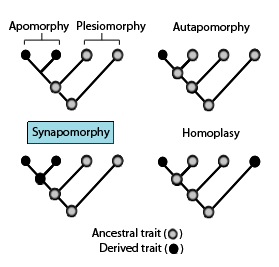Related Research Articles

The modern synthesis was the early 20th-century synthesis reconciling Charles Darwin's theory of evolution and Gregor Mendel's ideas on heredity in a joint mathematical framework. Julian Huxley coined the term in his 1942 book, Evolution: The Modern Synthesis.

A phylogenetic tree is a branching diagram or a tree showing the evolutionary relationships among various biological species or other entities based upon similarities and differences in their physical or genetic characteristics. All life on Earth is part of a single phylogenetic tree, indicating common ancestry.

The molecular clock is a figurative term for a technique that uses the mutation rate of biomolecules to deduce the time in prehistory when two or more life forms diverged. The biomolecular data used for such calculations are usually nucleotide sequences for DNA, RNA, or amino acid sequences for proteins. The benchmarks for determining the mutation rate are often fossil or archaeological dates. The molecular clock was first tested in 1962 on the hemoglobin protein variants of various animals, and is commonly used in molecular evolution to estimate times of speciation or radiation. It is sometimes called a gene clock or an evolutionary clock.

Evolutionary biology is the subfield of biology that studies the evolutionary processes that produced the diversity of life on Earth. Simply, it is also defined as the study of the history of life forms on Earth. Evolution is based on the theory that all species are related and they gradually change over time. In a population, the genetic variations affect the physical characteristics i.e. phenotypes of an organism. These changes in the phenotypes will be an advantage to some organisms, which will then be passed onto their offspring. Peppered Moth and Flightless birds are some examples of evolution in species over many generations. In the 1930s, the discipline of evolutionary biology emerged through what Julian Huxley called the modern synthesis of understanding, from previously unrelated fields of biological research, such as genetics and ecology, systematics, and paleontology. A person who studies Evolutionary biology is called an Evolutionary biologist. The importance of studying Evolutionary biology is mainly to understand the principles behind the origin and extinction of species.

In phylogenetics, an apomorphy is a novel character or character state that has evolved from its ancestral form. A synapomorphy is an apomorphy shared by two or more taxa and is therefore hypothesized to have evolved in their most recent common ancestor. In cladistics, synapomorphy implies homology.
Richard D. Alexander was an American zoologist who was a professor at the University of Michigan and curator at the university's museum of zoology of in Ann Arbor, Michigan. His scientific pursuits integrated the fields of systematics, ecology, evolution, natural history and behavior. The salient organisms in his research are wide-ranging, from the orthopterans and cicadidae (cicadas) to vertebrates: dogs, horses, and primates, including humans.

Joseph "Joe" Felsenstein is a Professor Emeritus in the Departments of Genome Sciences and Biology at the University of Washington in Seattle. He is best known for his work on phylogenetic inference, and is the author of Inferring Phylogenies, and principal author and distributor of the package of phylogenetic inference programs called PHYLIP. Closely related to his work on phylogenetic inference is his introduction of methods for making statistically independent comparisons using phylogenies.
Phylogenetic comparative methods (PCMs) use information on the historical relationships of lineages (phylogenies) to test evolutionary hypotheses. The comparative method has a long history in evolutionary biology; indeed, Charles Darwin used differences and similarities between species as a major source of evidence in The Origin of Species. However, the fact that closely related lineages share many traits and trait combinations as a result of the process of descent with modification means that lineages are not independent. This realization inspired the development of explicitly phylogenetic comparative methods. Initially, these methods were primarily developed to control for phylogenetic history when testing for adaptation; however, in recent years the use of the term has broadened to include any use of phylogenies in statistical tests. Although most studies that employ PCMs focus on extant organisms, many methods can also be applied to extinct taxa and can incorporate information from the fossil record.
In biology, a species is the basic unit of classification and a taxonomic rank of an organism, as well as a unit of biodiversity. A species is often defined as the largest group of organisms in which any two individuals of the appropriate sexes or mating types can produce fertile offspring, typically by sexual reproduction. Other ways of defining species include their karyotype, DNA sequence, morphology, behaviour or ecological niche. In addition, paleontologists use the concept of the chronospecies since fossil reproduction cannot be examined.
Incomplete lineage sorting, also termed deep coalescence, retention of ancestral polymorphism, or trans-species polymorphism, describes a phenomenon in population genetics when ancestral gene copies fail to coalesce into a common ancestral copy until deeper than previous speciation events. In other words, the tree produced by a single gene differs from the population or species level tree, producing a discordant tree. Effects caused by lineage sorting of genetic polymorphisms that were retained across successive nodes in the species tree have been called hemiplasy. Whatever the mechanism, the result is that a generated species level tree may differ depending on the selected genes used for assessment. This is in contrast to complete lineage sorting, where the tree produced by the gene is the same as the population or species level tree. Both are common results in phylogenetic analysis, although it depends on the gene, organism, and sampling technique.

The following outline is provided as an overview of and topical guide to evolution:

Reticulate evolution, or network evolution is the origination of a lineage through the partial merging of two ancestor lineages, leading to relationships better described by a phylogenetic network than a bifurcating tree. Reticulate patterns can be found in the phylogenetic reconstructions of biodiversity lineages obtained by comparing the characteristics of organisms. Reticulation processes can potentially be convergent and divergent at the same time. Reticulate evolution indicates the lack of independence between two evolutionary lineages. Reticulation affects survival, fitness and speciation rates of species.

Leslie Jane Rissler is an American biologist best known for her work on amphibian and reptile biogeography, evolutionary ecology, systematics, and conservation, and for her strong advocacy of improving the public’s understanding and appreciation of evolution. She is currently Program Officer in the Evolutionary Processes Cluster of the Division of Environmental Biology and Directorate of Biological Sciences at the National Science Foundation.
Amitabh Joshi is an Indian evolutionary biologist, geneticist and a professor at Jawaharlal Nehru Centre for Advanced Scientific Research (JNCASR). He heads the Evolutionary Biology Laboratory at JNCASR and is known for his studies on Genetics and Population ecology. An elected fellow of the Indian Academy of Sciences, National Academy of Sciences, India, and Indian National Science Academy, he is also a J. C. Bose National Fellow of the Department of Science and Technology. The Council of Scientific and Industrial Research, the apex agency of the Government of India for scientific research, awarded him the Shanti Swarup Bhatnagar Prize for Science and Technology, one of the highest Indian science awards, in 2009, for his contributions to biological sciences.
David P. Mindell is an American evolutionary biologist and author. He is currently a visiting scholar at the University of California, Berkeley, Museum of Vertebrate Zoology. Mindell's work is focused on the systematics, conservation and molecular evolution of birds, especially birds of prey. He is known for his 2006 book, The Evolving World in which he explained, for the general public, how evolution applies to everyday life.
Pedro Diego Jordano Barbudo is an ecologist, conservationist, researcher, focused on evolutionary ecology and ecological interactions. He is an honorary professor and associate professor at University of Sevilla, Spain. Most of his fieldwork is done in Parque Natural de las Sierras de Cazorla, Segura y Las Villas, in the eastern side of Andalucia, and in Doñana National Park, where he holds the title of Research Professor for the Estacion Biologica Doñana, Spanish Council for Scientific Research (CSIC).
Maria R. Servedio is a Canadian-American professor at the University of North Carolina at Chapel Hill. Her research spans a wide range of topics in evolutionary biology from sexual selection to evolution of behavior. She largely approaches these topics using mathematical models. Her current research interests include speciation and reinforcement, mate choice, and learning with a particular focus on evolutionary mechanisms that promote premating (prezygotic) isolation. Through integrative approaches and collaborations, she uses mathematical models along with experimental, genetic, and comparative techniques to draw conclusions on how evolution occurs. She has published extensively on these topics and has more than 50 peer-reviewed articles. She served as Vice President in 2018 of the American Society of Naturalists, and has been elected to serve as President in 2023.
Victoria Louise Sork is an American scientist who is Professor and Dean of Life Sciences at University of California, Los Angeles. She studies tree populations in California and the Eastern United States using genomics, evolutionary biology and conservation biology. Sork is a Fellow of the American Association for the Advancement of Science.
Trioecy, or subdioecy, is a rare sexual system characterized by the coexistence of males, females, and hermaphrodites. It has been found in both plants and animals. Trioecy is sometimes referred to as a mixed mating system alongside androdioecy and gynodioecy.
Lynette Gai Cook is an Australian botanist and entomologist. She earned a PhD from the ANU in 2001 with a thesis entitled The biology, evolution and systematics of the Gall-inducing scale insect Apiomorpha Rübsaamen
References
- 1 2 3 4 "L. Lacey Knowles". University of Michigan. Archived from the original on 4 March 2016. Retrieved 14 April 2015.
- ↑ "L. Lacey Knowles talks with ScienceWatch.com and answers a few questions about this month's Fast Breaking Paper in the field of Environment & Ecology" (PDF). No. Fast Breaking Papers. Thomson Reuters. ScienceWatch. December 2008. Retrieved 14 April 2015.
- ↑ "Heredity: About the Journal". Heredity. Retrieved 14 April 2015.
- ↑ Knowles, L. Lacey; Kubatko, Laura S., eds. (September 2010). Estimating Species Trees: Practical and Theoretical Aspects. Wiley-Blackwell. ISBN 978-0-470-52685-9.